Remove the air duct(A).

Use fender covers to avoid damaging painted surfaces.
To avoid damaging the cylinder head, wait until the engine coolant temperature drops below normal temperature before removing it.
When handling a metal gasket, take care not to fold the gasket or damage the contact surface of the gasket.
To avoid damage, unplug the wiring connectors carefully while holding the connector portion.
Mark all wiring and hoses to avoid misconnection.
Turn the crankshaft pulley so that the No. 1 piston is at top dead center.
Remove the terminals and thebattery.
Remove the air duct(A).

Remove the engine cover.
Remove the air cleaner assembly.
Disconnect the air flow sensor(AFS) connector(A).
Remove the breather hose(B).
Remove the air cleaner upper hose(C) and the intake hose(D).

Remove the air cleaner lower cover.
Remove the upper radiator hose(A) and lower radiator hose(B).

Remove the fuel inlet hose(A) from the delivery pipe.

Disconnect the engine wiring harness connectors.
Disconnect the No.1/No.2 knock sensor connectors(A,B), the oil pressure switch connector(C), the ignition coil harness(D) and the No.1 Variable Induction System(VIS) connector(E).
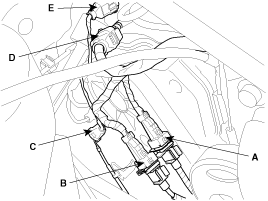
Disconnect the bank 1 front/rear O2 sensor connectors(A).
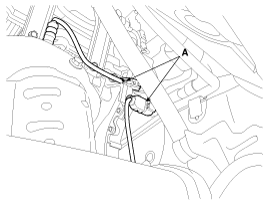
Disconnect the injection connectors(A,B,C), the ground lines(D), the condensor connector(E) and the Ignition coil connectors(F).
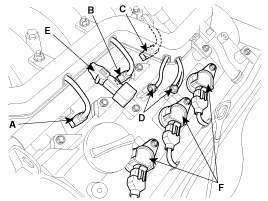
Disconnect the injection harness connector(A), the No.2 Variable Induction System(VIS) connector(B), the No.1/No.2 Oil Control Valve(OCV) connectors(C,D) and the Oil Temperature Sensor(OTS) connector(E).

Disconnect the Manifold Absolute Pressure Sensor(MAPS) connector(A), the Electronic Throttle Control(ETC) connector(B) and the Purge Control Solenoid Valve(PCSV) connector(C).
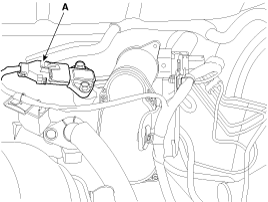
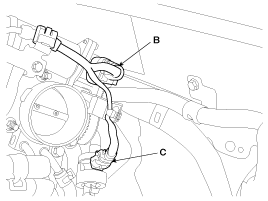
Disconnect the generator connector(A) and the air conditioning compressor connector(B).
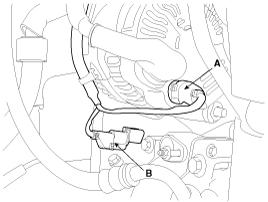
Disconnect the bank 2 Camshaft Position Sensor(CMPS) connector(A) and the Engine Coolant Temperature(ECT) sensor connector(B).
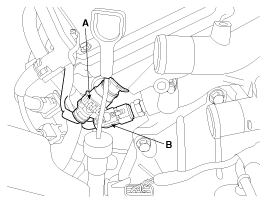
Disconnect the bank 2 front/rear oxygen sensor connectors(A,B) and the Crankshaft Position Sensor(CKPS) connector(C).
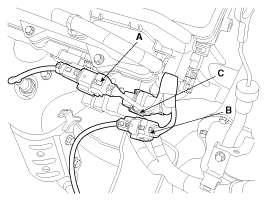
Disconnect the bank 1 Camshaft Position Sensor(CMPS) sensor connector(A).
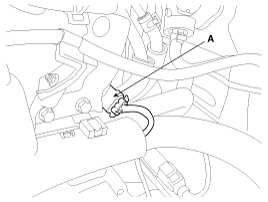
Remove the Pulge Control Valve(PCV) hose(A).
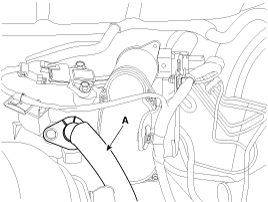
Disconnect the brake vacuum hose(A).
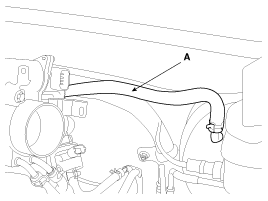
Remove the heater hoses(A).
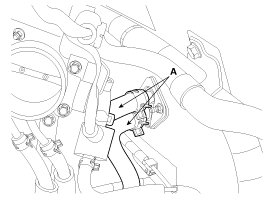
Remove the drive belt(A).

Remove the power steering pump.(Refer to Power steering pump in ST Group).
Remove the exhaust manifold assembly.(Refer to Exhaust manifold in this Group).
Remove the intake manifold assembly.(Refer to Intake manifold in this Group).
Remove the timing belt.(Refer to Timing system in this Group).
Remove the ignition coils.
Remove the water temp. control assembly.
Remove the cylinder head cover(A).
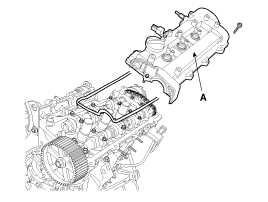
Remove the camshaft bearing cap(A).

Remove the timing chain tensioner(A).
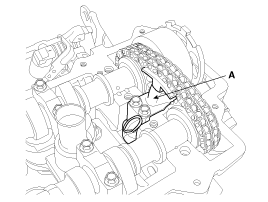
Remove the camshaft.
Remove the bank 2 timing belt rear cover(A).
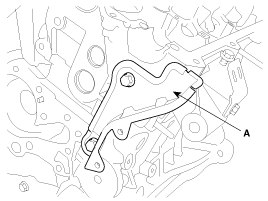
Remove the bank 1 timing belt rear cover(A).
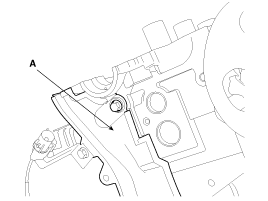
Remove the CKP sensor connector bracket(A).
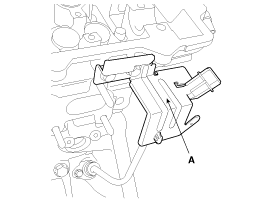
Remove the cylinder head assembly.
Remove the bolts in 2~3 steps as following orders.

Cylinder head damage may result if the bolts are not removed in the specified order.
Put the cylinder head assembly on a wooden block after removal from the cylinder block.
Ensure that the surface between the cylinder head and the block is not damaged.
Using the SST(09221-3F100), remove the valve guide from the downside of the cylinder head assembly.
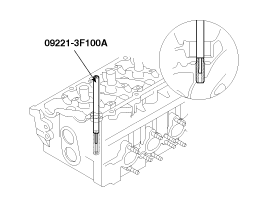
Reprocess the valve guide hole for the oversized valve guide newly installed.
Using the SST(09221-3F100), insert the valve guide in the upside of the cylinder head assembly. Be aware of the difference in length between the intake and the exhaust valve guides.
Specification
Intake valve guide: 45.8 ~ 46.2mm(1.8031 ~ 1.8189in.)
Exhaust valve guide: 46.8 ~ 47.2mm(1.8425 ~ 1.8583in.)

After installing the valve guides, insert new valves and check the clearance between the valve stems and the valve guides.
After replacing the valve guides, check if they are properly installed with the valve seats. Reprocess valve seats if necessary.
Identify MLA(Mechanical Lash Adjuster), valves and valve springs as they are removed so that each item can be reinstalled in its original position.
Remove MLA(Mechanical Lash Adjuster)s(A).
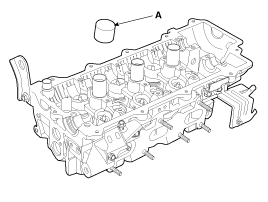
Remove valves.
Using SST(09222-3K000, 09222-3C300), compress the valve spring and remove retainer lock.
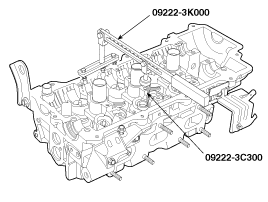
Remove the spring retainer.
Remove the valve spring.
Remove the valve.
Using SST(09222-29000), remove the valve stem seal.
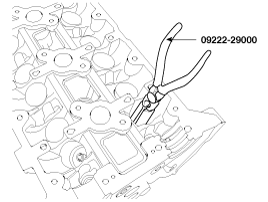
Do not reuse the removed valve stem seals.
Remove OCV(Oil Control Valve)(A).
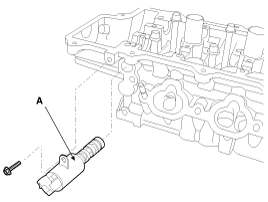
Inspect for flatness.
Using a precision straight edge and feeler gauge, measure the surface contacting cylinder block and the manifolds for warpage.
Flatness of cylinder head gasket surface
Standard : 0.03mm(0.0012in.) or less
Flatness of manifold gasket surface
Standard : 0.15mm(0.0059in.) or less
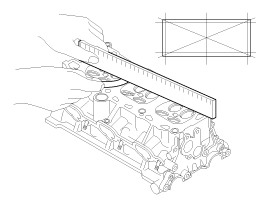
Inspect for cracks.
Check the combustion chamber, intake ports, exhaust ports and cylinder block surface for cracks. If cracked, replace the cylinder head.
Inspect valve stems and valve guides.
Using a caliper gauge, measure the inside diameter of the valve guide.
Valve guide inside diameter
Intake / Exhaust : 6.000 ~ 6.015mm (2.2362 ~ 2.2368in.)
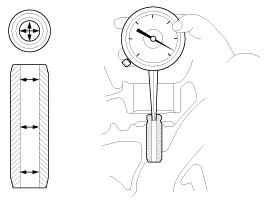
Using a micrometer, measure the outer diameter of the valve stem.
Valve stem outer diameter
Intake : 5.965 ~ 5.980mm (0.2348 ~ 0.2354in.)
Exhaust : 5.950 ~ 5.565mm (0.2343 ~ 0.2348in.)

Calculate the clearance between the valve guides and the stems by difference between the valve stem measured diameter and the valve guide measured inside diameter.
Valve stem-to-guide clearance
[Standard]
Intake : 0.020 ~ 0.050mm (0.0008 ~ 0.0020in.)
Exhaust : 0.035 ~ 0.065mm (0.0014 ~ 0.0026in.)
[Limit]
Intake : 0.10mm (0.0039in.) or less
Exhaust : 0.13mm (0.0051in.) or less
Inspect valves.
Check the valve face angle.
Check that the surface of the valve for wear.
If the valve face is worn, replace the valve.
Check the valve head margin thickness.
If the margin thickness is less than the specification, replace the valve.
Specification
Intake : 1.0mm(0.0394in.)
Exhaust : 1.3mm(0.0512.)

Check the valve length.
Length
Intake : 110.1mm(4.3346in)
Exhaust : 111.1mm(4.3740in)
Check the surface of the valve stem tip for wear.
If the valve stem tip is worn, replace the valve.
Inspect valve seats
Check the valve seat for evidence of overheating or improper contact with the valve face.
If the valve seat is worn, replace cylinder head.
Before reconditioning the seat, check the valve guide for wear. If the valve guide is worn, replace the valve guide first.
Recondition the valve seat with a valve seat grinder or cutter. The valve seat contact width should be within specifications and centered on the valve face.
Inspect valve springs.
Using a steel square, measure the out-of-square of the valve spring.
Using vernier calipers, measure the free length of the valve spring.
Valve spring
[Standard]
Free height : 46.8mm (1.8425in.)
Out-of-square : 1.5˚ or less
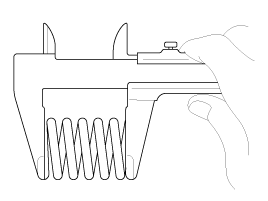
Inspect MLA.
Using a micrometer, measure the MLA outside diameter.
MLA O.D.
Intake/Exhaust : 29.964 ~ 29.980mm(1.1797 ~ 1.1803in.)
Using a caliper gauge, measure MLA tappet bore inner diameter of cylinder head.
Tappet bore I.D.
Intake/Exhaust : 30.000 ~ 30.025mm(1.1811 ~ 1.1821in.)
Calculate the clearance by subtracting MLA outside diameter measurement from tappet bore inside diameter measurement.
MLA to tappet bore clearance
[Standard]
Intake/Exhaust : 0.020 ~ 0.061mm(0.0008 ~ 0.0024in.)
[Limit]
Intake/Exhaust : 0.07mm(0.0027in.) or less
Inspect cam lobes.
Using a micrometer, measure the cam lobe height.
Cam height
[Standard value]
Intake : 44.5mm (1.7520in.)
Exhaust : 44.5mm (1.7520in.)
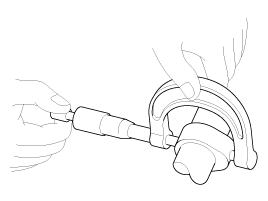
If the cam lobe height is less than standard, replace the camshaft.
Check the cam lobe surface for wear or damage. If necessary, replace it.
Inspect camshaft journal clearance.
Clean the bearing caps and camshaft journals.
Place the camshafts on the cylinder head.
Lay a strip of plastigage across each of the camshaft journals.
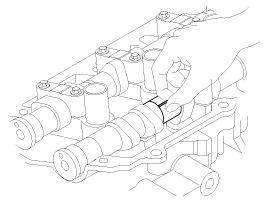
Install the bearing caps with the tightening torque.
Do not turn the camshaft.
Remove the bearing caps.
Measure the plastigage at its widest point.
Bearing oil clearance
[Standard value]
Intake : 0.030 ~ 0.057mm (0.0012 ~ 0.0022in.)
Exhaust : 0.030 ~ 0.057mm (0.0012 ~ 0.0022in.)
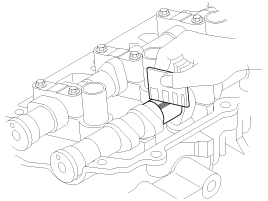
If the oil clearance is greater than the maximum, replace the camshaft. If necessary, replace the cylinder head.
Completely remove the plastigage.
Remove the camshafts.
Inspect camshaft end play.
Install the camshafts.
Using a dial indicator, measure the end play while moving the camshaft back and forth.
Camshaft end play
[Standard value] : 0.1 ~ 0.2mm(0.0039 ~ 0.0079in.)

If the end play is greater than the maximum, replace the camshaft. If necessary, replace the cylinder head.
Remove the camshafts.
Inspect CVVT assembly.
Fix the CVVT assembly with a vice. Ensure that the cam lobe and journal is not damaged.
Check that the CVVT assembly will not turn.
It should not be turned.
Apply vinyl tape to the retard hole except the one(A) indicated by the arrow in the illustration.
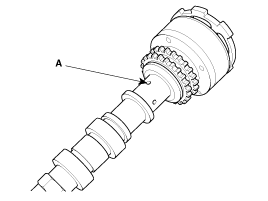
Wind tape around the tip of the air gun and apply air of approx. 150kpa(1.5kgf/cm², 21psi) to the port of the camshaft.
(Perform this in order to release the lock pin for the maximum delay angle locking.)
When the oil splashes, wipe it off with a shop rag.
After the lock pin released, the CVVT assembly can turned in advanced direction.
Except the position where the lock pin meets at the maximum delay angle, let the CVVT assembly turn back and forth and check the movable range and that there is no resistance to movement.
Standard: Movable smoothly in the range about 60°
Turn the CVVT assembly with your hand in retard direction and lock it at the maximum delay angle position.
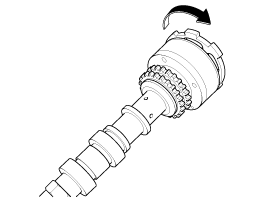
Thoroughly clean all parts to be assembled.
Before installing the parts, apply fresh engine oil to all sliding and rotating surfaces.
Replace oil seals with new ones.
Install valves.
Using SST(09222-22001), push in a new valve stem seal while applying engine oil.
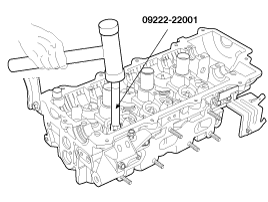
Do not reuse old valve stem seals.
Incorrect installation of the seal could result in oil leakage past the valve guides.
Reassemble the valve stem seals
After applying engine oil on the outer surface of each valve stem, insert the valve in the valve guide.
Install the valve, valve spring and spring retainer.
When installing valve springs, the side coated with enamel should face toward the valve spring retainer
Using the SST(09222 - 3K000, 09222-3C300), compress the springs and install the retainer locks. After installing the valves, ensure that the retainer locks are correctly in place before releasing the valve spring compressor.
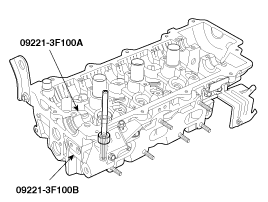
Lightly tap the end of each valve stem two or three times with the wooden handle of a hammer to ensure proper seating of the valve and retainer lock.
Install MLAs with engine oil applied on its surface.
Check that the MLA rotates smoothly by hand.

MLA should be reinstalled in its original position.
Install OCV(Oil Control Valve)(A).
Tightening torque
7.8 ~ 9.8Nm(0.8 ~ 1.0kgf.m, 5.8 ~ 7.2lb-ft)
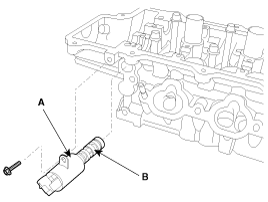
To install OCV with gray colored connector into RH bank.
To install OCV with black colored connector into LH bank.
Do not reuse the OCV when dropped.
Keep clean the OCV.
Do not hold the OCV sleeve during servicing.
When the OCV is installed on the engine, do not move the engine while holding the OCV yoke.
Remove any dust from the OCV prior to installation.
Thoroughly clean all parts to be assembled.
Always use a new head and manifold gasket.
The cylinder head gasket is a metal gasket. Take care not to bend it.
Rotate the crankshaft to set the No.1 cylinder piston at TDC.
After putting the cylinder head gasket on the cylinder block, install the cylinder head.
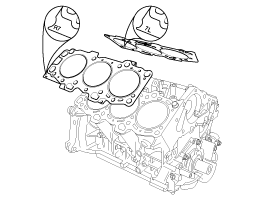
Ensure the LH/RH classification of the cylinder head gasket when installing.
Tighten the cylinder head bolts with the plain washers in several steps as following order.
In assembling washers, the marked surface should face upward.
In installing the cylinder head bolts, apply engine oil on the thread of the bolts and the surface of the washers.
Always use new cylinder head bolts.
Tightening torque
22.6~26.5Nm (2.3~2.7kgf.m, 16.6~19.5lb-ft) + 58~62° + 43~47°
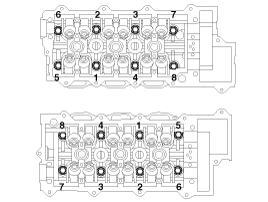
Using the SST(09221-4A000), tighten the bolts which need to be tightened with the angular tightening method.
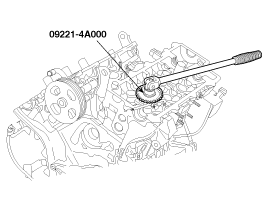
Install the CVVT assembly and camshaft chain sprocket with the dowel pin in the CVVT installed to the intake camshaft. Ensure that the pin will not be installed in the hole for oil feeding.
Tightening torque
66.7~78.5Nm(6.8~8.0kgf.m, 49.2~57.9lb-ft)
After tightening the CVVT bolts, rotate the CVVT assembly housing counterclockwise by hand to seat the lock pin in the CVVT assembly in good position.
Fix the hexagonal part of the camshaft in a vice when tightening the CVVT bolts. Do not fix the CVVT housing or sprocket in a vice.
Install the camshaft in the cylinder head assembly.
Intake Camshaft
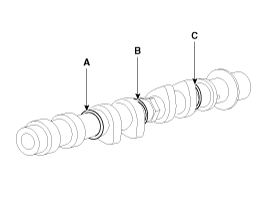
As for camshaft identification, refer to the table below.
Displacement | Outer diameter | |
LH | RH | |
Intake Camshaft | A : 32mm(1.2598in.) | A : 32mm(1.2598in.) |
B : 32mm(1.2598in.) | B : 30mm(1.1811in.) | |
C : 32mm(1.2598in.) | C : 32mm(1.2598in.) | |
Exhaust Camshaft
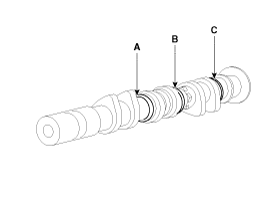
As for camshaft identification, refer to the table below.
Displacement | Outer diameter | |
LH | RH | |
Exhaust Camshaft | A : 32mm(1.2598in.) | A : 32mm(1.2598in.) |
B : 32mm(1.2598in.) | B : 30mm(1.1811in.) | |
C : 30mm(1.1811in.) | C : 30mm(1.1811in.) | |
Align the timing marks of the intake and exhaust camshaft chain sprockets and the timing chain.
Both timing marks should face upward for reassembly.
Install the intake and exhaust camshafts on the cylinder head with the timing marks aligned.
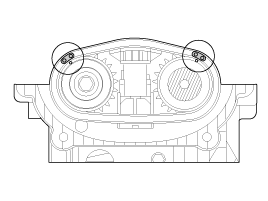
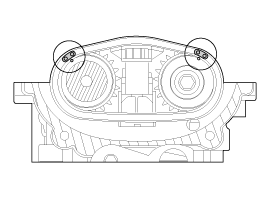
Install the timing chain tensioner.
Insert the set pin by pressing the timing chain tensioner.
Install the chain tensioner(A) in the cylinder head assembly.
Tightening torque
10.8~12.7 N.m (1.1~1.3 kgf.m, 8.0~9.4 Ib-ft)

Install the camshaft bearing caps(A, B).
Tightening torque
Bearing cap bolt(A: 6×38) - 10.8~12.7Nm(1.1~1.3kgf.m, 8.0~9.4lb-ft)
Bearing cap bolt(B: 8×38) - 20.6~22.5Nm(2.1~2.6kgf.m, 15.2~18.8lb-ft)
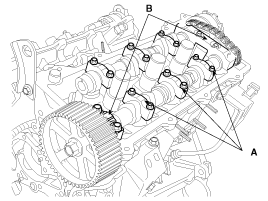
When installing the bearing caps, check the marks on them as shown below and install them in its proper position.

A(LH/RH HEAD): L(LH), R(RH)
B(Intake/Exhaust): I(Intake), E(Exhaust)
C(Cap no.): 1,2,3
When installing the bearing caps, turn the crankshaft to place a piston in the middle of the block because linterference between valves and pistons can occur.
Using the SST(09214-21000), install the camshaft oil seal.
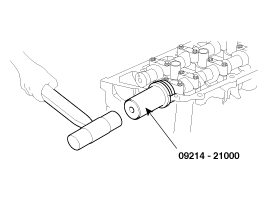
Befor installing, apply engine oil.
The camshaft cap surface should adhere to the cylinder head assembly.
Do not press an eccentric load.
Install the camshaft sprocket.
Hold the hexagonal head wrench portion of the camshaft with a vise, and install the bolt.
Tightening torque
88.3 ~ 107.9Nm (9.0 ~ 11.0kgf.m, 65.1 ~ 79.6lb-ft)
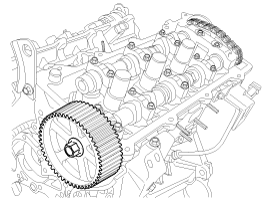
In case that the camshaft is replaced with new one, inspect the valve clearances and then install appropriate MLA tappet. (Refer to Valve clearance inspection and adjustment)
To prevent the valve from interfering with the piston, rotate the crankshaft sprocket at 3 pitches counterclockwise from the No.1 cylinder piston at TDC position before inspecting the valve clearances.
Install the CKP sensor connector bracket(A).

Install the bank 1 timing belt rear cover(A).

Install the bank 2 timing belt rear cover(A).
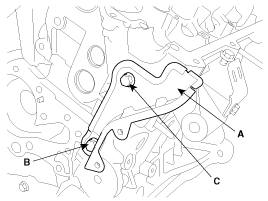
The length of the bolt B is longer than that of the bolt C.
Install the cylinder head cover.
Remove oil, dust or sealant on the upper surface of the cylinder before assembling cylinder head cover.
Assemble the cylinder head cover within 5 minites after applying liquid gasket(LOCTITE 5900) on the camshaft cap and packing part.
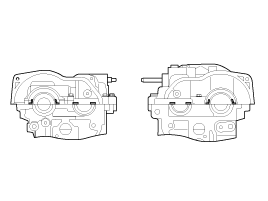
Tighten the cylinder head cover bolts as following order(A).
Tightening torque
7.8~9.8Nm(0.8~1.0kgf.m, 5.8~7.2lb-ft)
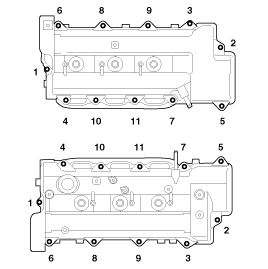
Do not start engine for thirty minites after assembling the cylinder head cover.
Do not reuse the cylinder head cover gasket.
Install the timing belt.
Align the timing marks of the LH/RH camshaft sprockets.
To prevent the valve from interfering with the piston, rotate the crankshaft sprocket at 3 pitches counterclockwise from the No.1 cylinder piston at TDC position before aligning the timing marks of the camshaft sprockets.
After aligning the timing marks of the camshaft sprockets, rotate the crankshaft sprocket at 3 pitches clockwise then align the timing mark of the crankshaft sprocket to set the crankshaft to the No.1 cylinder piston at TDC position.
Install the timing belt. (Refer to Timing system)
Install the water temp. control assembly.
Install the engine support bracket.
Over torque can damage thread of cylinder block.
Install the intake manifold assembly.
Install the exhaust mainfold assembly.
Install the power steering pump.
Install the drive belt(A).

After inserting the drive belt between engine support bracket and power steering pump (or idle pulley), install the drive belt as above and the tensioner arm applying force to counter-clockwise with a wrench).
Install the heater hose(A).

Connect the brake vaccume hose(A).

Install the Purge Control Valve(PCV) hose(A).

Connect the engine wiring harness connectors.
Connect the bank 1 Camshaft Position Sensor(CMPS) connector(A).

Connect the bank 2 front/rear oxygen sensor connectors(A,B) and the Crankshaft Position Sensor(CKPS) connector(C).

Connect the bank 2 Camshaft Position Sensor(CMPS) connector(A) and the Water Temperature Sensor(WTS) connector(B).

Connect the generator connector(A) and the air conditioning compressor connector(B).

Connect the Manifold Absolute Pressure Sensor(MAPS) connector(A), the Electronic Throttle Control(ETC) connector(B) and the Purge Control Solenoid Valve(PCSV) connector(C).


Connect the injection harness connector(A), the No.2 Variable Induction System(VIS) connector(B), the No.1/No.2 Oil Control Valve(OCV) connectors(C,D) and the Oil Temperature Sensor(OTS) connector(E).

Connect the injection connectors(A,B,C), the ground lines(D), the condensor connector(E) and the Ignition coil connectors(F).

Connect the bank 1 front/rear oxygen sensor connectors(A).

Connect the No.1/No.2 knock sensor connectors(A,B), the oil pressure switch connector(C), the ignition coil harness(D) and the No.1 Variable Induction System(VIS) connector(E).

Install the fuel inlet hose(A) from the delivery pipe.

Install the upper radiator hose(A) and lower radiator hose(B).

Install the air cleaner assembly.
Install the air cleaner lower cover.
Install the air cleaner intake(D) and the air cleaner upper hose(C).
Install the breather hose(B).
Connect the Air Flow Sensor(AFS) connector(A).

Install the air duct(A).

Install the engine cover.
Refill engine coolant.